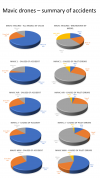Don't really understand this thread. Not many or any examples of what can go wrong (I don't read the forum much, came here from a link in an email). I've had my
MA2 for a couple of months, logged about 10 flights, rural area, never go more than 400m away, max height 150m (no aircraft fly around here). Very wary of flying low around obstacles. No crashes, no accidents. A few wind warnings. My phone never seems to be able to get the machine's location right (the little indicator of direction at the bottom of the screen in the app is always just a red box).
What would be useful is a list of mishaps in short paragraph form, to get newbies aware of the pitfalls, eg:
Case One
======
Operator inadvertently flew beyond the communications range of drone. Drone lost.
Case Two
======
Operator flew drone into tree. Drone a write-off.
etc.











